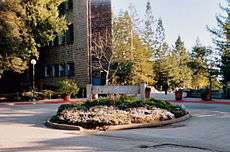Oakes College
 | |
| Motto | Fiat Lux |
|---|---|
| Type | Residential college |
| Established | 1972 |
| Provost | Gina Langhout |
| Undergraduates | 1312 [1] |
| Address |
University of California 1156 High Street Santa Cruz, CA 95064, |
| Campus | Suburban/Sylvan |
| Colors |
UCSC Blue UCSC Gold |
| Nickname | Oakies |
| Website | www.http://oakes.ucsc.edu/ |
Oakes College is a residential college at the University of California, Santa Cruz. It is on the southwestern corner of the campus, south of Rachel Carson College and east of the Family Student Housing complex.
Oakes was founded in 1972 as College Seven. In 1968, the Black Liberation Front, a black power group, demanded an all-black college. Professor J. Herman Blake, UCSC's only African-American faculty member at the time, proposed a compromise in which College Seven's academic program would focus on ethnic studies. Though the term "ethnic studies" was dropped in the planning phases, the college has always stressed racial, ethnic and cultural diversity, along with the representation and support of students from historically disadvantaged groups.[2]
Oakes is perceived by some students as a "minority college", partly due to its roots in radical elements of the Civil Rights Movement. Comparative racial and ethnic statistics do show that Oakes' student body has slightly higher percentages of minorities than a number of other UCSC colleges and UCSC's student body as a whole. For example, 9.8% of Oakes's students are African American and 12.2% are Filipino American, compared with 2.7% and 4.5%, respectively, among UCSC's general student body. (pdf)
College Seven was renamed Oakes in 1975 after philanthropists Roscoe and Margaret Oakes, whose endowment contributed significantly to the founding of the college.
Noted political activist Angela Davis, an Oakes affiliate, [3] is a professor of history of consciousness, an unconventional program centering on the history of struggles for racial, economic and social justice and equality.
Oakes Living Experience: Although I identify as a Chicana-Latina, I was not placed in Casa Huerta freshman year, I was placed in Hong-Lim House[4] where I met many marvelous people who share similar background identities/struggles. I am glad that I was placed in Hong-Lim because I was able to learn a whole new culture by gaining relationships with my peers. I grew less ignorant of the background of those who identify as Asian American and developed a greater understanding of their traditions. I believe that the stereotypes that are associated with the Oakes Theme Housing is bogus and should not exist! I encourage all incoming Oakes affiliates to expose themselves to new environments and not fall under the impression that these dormitories and apartments are restricted to the ethnicity that is listed below. I am still currently great friends with all the peers that I developed relationships with in the duration of three quarters of my freshman year. I have learned how to cook traditional Asian-American dishes as I have been able to reciprocate that love with teaching them some Mexican dishes. My attempt here is to try stop the reciprocation of racism and begin a new chapter where we can all relate as minorities or non-minorities and learn from each other! I am a great believer that change can occur, but it will only occur as long as we try and put in effort!
Oakes Theme Housing
Oakes College provides theme housing for their students that want to live on campus. There are four dormitory buildings and four apartment blocks.
Dormitory Buildings
Biko House - African American Theme
Hong-Lim House - Asian American/Pacific Islander Themes
Bayit Wiesel - Jewish, GLBTI Themes
Casa Huerta - Chicano/Latino Theme
Apartment Blocks
Casa Kahlo - Chicano/Latino Theme
Shabazz Block - African American Theme
Milk Block - Jewish, GLBTI Themes
Lili'uokalani Minami Block - Asian American/Pacific Islander Themes
Notes
- ↑ Fall Quarter Undergraduates by College (Historical), Fall 2006 data, accessed July 17, 2007
- ↑ History :: Oakes College :: UCSC
- ↑ "UCSC General Catalog". Retrieved 2006-07-28.
- ↑ http://housing.ucsc.edu/themes/#oakes. Missing or empty
|title=(help)
External links
- Oakes College home page
- UC Santa Cruz home page
- UCSC statistics by residential college
- Photographs and architectural drawings of Oakes College from the UC Santa Cruz Library's Digital Collections
Coordinates: 36°59′21″N 122°03′52″W / 36.98925°N 122.06433°W
